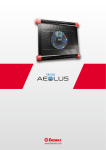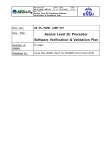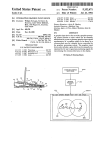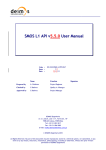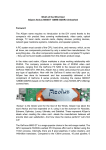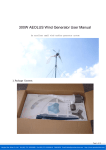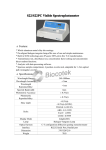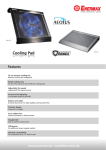Download AEOLUS LEVEL-2B PROCESSOR SOFTWARE USER'S MANUAL
Transcript
Aeolus Level-2B Processor Software User’s Manual Ref: AE-MA-ECMWF-L2BP-001 Version: 1.33 Date: 29 Feb 2008 AEOLUS LEVEL-2B PROCESSOR SOFTWARE USER’S MANUAL Authors David TAN, Erik ANDERSSON ECMWF Jos De KLOE, Ad STOFFELEN, KNMI Dorit HUBER, DLR Paul POLI, Alain DABAS, MÉTÉO-FRANCE 1/28 Aeolus Level-2B Processor Software User’s Manual Ref: AE-MA-ECMWF-L2BP-001 Version: 1.33 Date: 29 Feb 2008 CHANGE LOG Version 0.1 1.0 1.1 1.2 Date 29 Nov 2005 05 May 2006 21 Aug 2006 7 Dec 2006 1.3 1.32 23 Feb 2007 16 Jan 2008 1.33 29 Feb 2008 Comment Initial draft To accompany Level-2B Processor Issue 1.0 To accompany Level-2B Processor Issue 1.1. To accompany Level-2B Processor Issue 1.2 (first version for CorePDS). To accompany Level-2B Processor Issue 1.3. To accompany Level-2B Processor Issue 1.32. Updates to usage instructions, including supplementary tools. To accompany Level-2B Processor Issue 1.33. Update FakeDateTime invocation for Level-1B EE2Bufr convertor. Update ConvertKnmiAsctoAMD command-line options. Change bars with respect to Version 1.32. 2/28 Aeolus Level-2B Processor Software User’s Manual Ref: AE-MA-ECMWF-L2BP-001 Version: 1.33 Date: 29 Feb 2008 Table of Contents PART 1: CONTEXT GUIDE .................................................................................................................... 5 1. Introduction....................................................................................................................................... 6 1.1. Purpose and Scope of Document.............................................................................................. 6 1.2. Structure and Contents of Document ........................................................................................ 6 1.3. Summary of Main Changes relative to Previous Version .......................................................... 6 2. Documents ....................................................................................................................................... 6 2.1. Applicable documents................................................................................................................ 6 2.2. Reference documents................................................................................................................ 7 2.3. Acronyms ................................................................................................................................... 7 3. System Context ................................................................................................................................ 9 3.1. Mission Objectives..................................................................................................................... 9 3.2. Basic Principles of Aeolus Instrument Operation ...................................................................... 9 3.2.1. The Aeolus lidar instrument ................................................................................................ 9 3.2.2. The instrument modes and viewing geometries ................................................................. 9 3.2.3. Downlink to the ground segment ...................................................................................... 12 3.3. Products Overview and Auxiliary Data .................................................................................... 12 3.4. Ground Segment and Primary Elements of Aeolus PDS ........................................................ 13 3.4.1. Aeolus Processing Facility (APF)...................................................................................... 13 3.4.2. Level-2 (Meteorological) Processing Facility (L2/Met-PF) ................................................ 13 3.4.3. Archives ............................................................................................................................ 14 3.4.4. Ground segment timelines for the operational processors ............................................... 14 4. Overview of the L2B Processor...................................................................................................... 16 4.1. Functional requirements .......................................................................................................... 16 4.2. Platform requirements ............................................................................................................. 16 4.2.1. Target platform for the PDS L2B late- and re-processor .................................................. 16 Hardware requirements............................................................................................................... 16 Software requirements ................................................................................................................ 16 4.3. Performance requirements ...................................................................................................... 16 4.4. Functional description.............................................................................................................. 17 4.5. Context of the L2BP and Processing Instances ...................................................................... 17 4.5.1. L2BP - reprocessing mode ............................................................................................... 17 5. External Interfaces - late- and re-processing mode ....................................................................... 19 6. External Interfaces - standalone scientific mode............................................................................ 19 6.1. Overview of I/O data (files, data streams) ............................................................................... 19 6.2. HMI Functionalities .................................................................................................................. 19 6.3. Processing Control .................................................................................................................. 19 6.4. Logfile, error handling .............................................................................................................. 19 6.5. Cleaning of intermediate files .................................................................................................. 19 7. External Interfaces - assimilation mode ......................................................................................... 19 7.1. Overview of I/O data (files, data streams) ............................................................................... 19 8. Installation and System Configuration............................................................................................ 20 8.1. System Requirements ............................................................................................................. 20 8.2. How to get the software ........................................................................................................... 20 8.3. How to compile the software ................................................................................................... 20 8.4. How to install and configure the software - standalone mode................................................. 20 8.5. How to run the software - standalone mode............................................................................ 20 8.6. How to install and configure the software - assimilation mode................................................ 21 8.7. How to retrieve and install external software library cfi ........................................................... 21 8.8. How to retrieve and install g95 ................................................................................................ 21 PART 2: OPERATIONS GUIDE............................................................................................................ 22 9. Scientific Principles ........................................................................................................................ 23 9.1. Algorithm Overview.................................................................................................................. 23 10. Software Implementation.............................................................................................................. 23 10.1. Software Principles and Top-Level Design............................................................................ 23 10.2. and following sub-sections: Description of individual modules, one subsection per module 23 11. Operation of the Aeolus L2B Processor - standalone mode........................................................ 23 3/28 Aeolus Level-2B Processor Software User’s Manual Ref: AE-MA-ECMWF-L2BP-001 Version: 1.33 Date: 29 Feb 2008 11.1. Operator Interface.................................................................................................................. 23 11.1.1. Main Control Panel.......................................................................................................... 23 11.1.2. Job Order Editor.............................................................................................................. 23 11.1.3. Auxiliary Data Editor........................................................................................................ 23 11.1.4. Product Viewer................................................................................................................ 23 11.1.5. Log Viewer ...................................................................................................................... 23 11.1.6. File Browser .................................................................................................................... 23 11.2. Job Order Execution .............................................................................................................. 24 11.3. Run-time Directory Structure ................................................................................................. 24 11.4. Storing of Configuration Parameters ..................................................................................... 24 11.5. Test Entry Points ................................................................................................................... 24 11.6. Examples ............................................................................................................................... 24 12. Operation of the Aeolus L2B Processor - assimilation mode....................................................... 24 13. Provision of Auxiliary Meteorological Data................................................................................... 24 14. Error Handling and Recovery ....................................................................................................... 24 15. Known Issues ............................................................................................................................... 24 16. Future Developments ................................................................................................................... 24 17. Feedback and Reporting Bugs..................................................................................................... 24 18. Frequently Asked Questions ........................................................................................................ 24 PART 3: APPENDICES......................................................................................................................... 25 19. Appendix A: Supplementary Tools ............................................................................................... 26 20. Appendix B: Summary of Error & Warning Messages, Recovery Procedures ............................ 27 21. Appendix C: Software Transfer Inventory .................................................................................... 27 22. Appendix D: Thin Layer Configuration Files................................................................................. 27 22.1. Workstation Configuration File .............................................................................................. 27 22.2. Task Table ............................................................................................................................. 28 22.3. Example Job Order................................................................................................................ 28 4/28 Aeolus Level-2B Processor Software User’s Manual Ref: AE-MA-ECMWF-L2BP-001 Version: 1.33 Date: 29 Feb 2008 AEOLUS LEVEL-2B PROCESSOR SOFTWARE USER’S MANUAL PART 1: CONTEXT GUIDE 5/28 Aeolus Level-2B Processor Software User’s Manual Ref: AE-MA-ECMWF-L2BP-001 Version: 1.33 Date: 29 Feb 2008 1. Introduction 1.1. Purpose and Scope of Document This document is the Software User’s Manual for the Aeolus Level-2B Processor (version 1.33). Its purpose is 1) to provide the context for the processor and its various modes, 2) to provide instructions for configuring the processor (mode-dependent), 3) to provide instructions for operating the processor (also mode-dependent), and 4) to enable the user to understand the scientific principles and software implementation of the L2B processor. For a more complete understanding of the L2B Processor, the reader is also referred to the following reference documents: [RD6, RD8, RD9]. 1.2. Structure and Contents of Document The document is structured in 3 main parts. Part 1 details the context for the processor and comprises a Context Guide (Chapters 1 to 8). Part 2 comprises an Operations Guide (Chapters 9 to 18). Part 3 contains a number of appendices (Chapters 19 to 22). To better understand the Level-2B Processor, the reader is encouraged to treat the User Manual as a single coherent document. In other words, the different parts are inter-related and should not be considered as disjoint from each other. For instructions on how to install the software as a standalone package, refer to the Software Release Notes accompanying each software release. Instructions on how to integrate the software within a data assimilation algorithm are provided in Section 8.6. 1.3. Summary of Main Changes relative to Previous Version Relative to version 1.32 of this document, minor amendments for consistency with L2B Processor Release 1.33. Updated usage instructions have been given for two supplementary tools, namely the Level-1B EE2Bufr convertor, and the KNMI-Ascii-to-Auxilliary-Meteorological-Data convertor. Many sections headings are given as placeholders for details that are to be added in future versions. 2. Documents 2.1. Applicable documents Ref [AD1] Document title Statement of Work of the Development and Production of L2B/C Aeolus data. 6/28 Document ref AE-SW-ESA-GS-0117 Ver 1B Date Sep 2004 Aeolus Level-2B Processor Software User’s Manual [AD2] [AD3] Answer to RFQ/3-11094/04/NL/MM. PDS to ECMWF: Interface Control Document. [AD4] Implementation of Level 2B/2C Processing Facility. Technical Requirements Earth Explorer Ground Segment File Format Standard [AD5] Ref: AE-MA-ECMWF-L2BP-001 Version: 1.33 Date: 29 Feb 2008 XADM-GSEG-EOPG-ID-04-0002 1.6 XADM-GSEG-EOPG-RD-04-0003 1.1 Jul 2004 Nov/Dec 2007 Jun 2004 PE-TN-ESA-GS-001 1.4 Jun 2003 Ver 3.0 Date Oct 2004 AE-SW-ASU-GS-023 AE-SW-ESA-GS-016 4.0 1.0 Jun 2006 Feb 2004 ADM-IC-52-1666 3/5 Feb 2008 AE-TN-MFG-L2P-0021 AE-TN-ESA-SY-007 AE-DD-ECMWF-L2BP-001 2.1 1B 1.0 Jun 2006 May 2004 Feb 2007 AE-TN-ECMWF-L2P-0022 1.2 Sep 2005 AE-TN-ECMWF-L2BP-0023 2.1 Feb 2007 AE-TN-MFG-GS-0001 AE-IF-ECMWF-L2BP-001 1.0 1.32 Oct 2005 Jan 2008 AE-IF-ECMWF-L2BP-002 1.32 Jan 2008 AE-TN-ECMWF-L2CP-0062 1.0 In Progress 2.2. Reference documents Ref [RD1] [RD2] [RD3] [RD4] [RD5] [RD6] [RD7] [RD8] [RD9] [RD10] [RD11] [RD12] [RD13] Document title Aladin Instrument Operation Definition REMOVED Level1B Master Algorithm Document Impact of line shape on wind measurements and correction methods L1B & E2S Input/Output Data Definitions Interface Control Document Selection of L2B/L2C Parameters (Study TN2.1) Aeolus Data Products Contents Guidelines ADM-Aeolus Level-2B Processor Design Document. See also Definition of Baseline Aeolus Level-2B Processing ADM-Aeolus Level-2B Algorithm Theoretical Baseline Document (Mathematical Description of the Aeolus Level 2B Processor) ILIAD Lookup Table - Detailed Processing Model ADM-Aeolus Level-2B/2C Processor Input/Output Data Definitions Interface Control Document ADM-Aeolus Level-2B Processor External Interface Control Document Definition of Baseline Aeolus Level-2C Processing (Study TN6.2) Document ref AE-TN-ASF-AL-00044 2.3. Acronyms ACCD Accumulation Charge Coupled Device AISP Annotated Integrated Source Packet AMD Auxiliary Meteorological Data AOCS Attitude and Orbit Control System BRC Basic Repeat Cycle CFI Customer Furnished Item DEM Digital Elevation Map E2S End-to-End Simulator ECMWF European Center for Medium-Range Weather Forecast EE Earth Explorer (H)LOS (Horizontal) Line Of Sight HSRL High Spectral Resolution Lidar IAT Instrument Auto-Test ISR Instrument Spectral Registration L1B Level-1B L2B Level-2B L2C Level-2C MPH Main Product Header NAG Numerical Algorithms Group NRT Near Real Time NWP Numerical Weather Prediction ODB Observation DataBase PDS Payload Data Segment PRF Pulse Repetition Frequency QRT Quasi Real Time SNR Signal to Noise Ratio SPH Specific Product Header WGS84 World Global System 84: Reference Ellipsoid for GPS data. 7/28 Aeolus Level-2B Processor Software User’s Manual WMO World Meteorological Organization 8/28 Ref: AE-MA-ECMWF-L2BP-001 Version: 1.33 Date: 29 Feb 2008 Aeolus Level-2B Processor Software User’s Manual Ref: AE-MA-ECMWF-L2BP-001 Version: 1.33 Date: 29 Feb 2008 3. System Context 3.1. Mission Objectives The Atmospheric Dynamics Mission (ADM-Aeolus) is the second of the European Space Agency’s Earth Explorer Core Missions. Its objective is to demonstrate the capability to measure wind profiles from space using a Doppler wind lidar. The need for such data, with high accuracy and good vertical resolution, has been identified as a priority for the global observing system. The polar orbit facilitates the global coverage that is required, particularly over ocean regions which are currently poorly observed. The accuracy of the ADM-Aeolus wind observations will depend primarily on the intensity of the backscattered laser light, which in turn depends on the presence and thickness of clouds, and the concentration of aerosol. It is expected that sufficient backscatter will be received from the layers of clear air above clouds, from cloud-top layers, from layers in and below thin cloud, from the gaps between broken cloud, and from layers with sufficient aerosol in the lower parts of the atmosphere. The mission objectives and observation requirements have been designed to meet scientific goals in user communities in climate research, atmospheric modelling and numerical weather prediction (NWP). Meteorological observations, particularly those with well-understood and well-quantified error characteristics, are an essential part of NWP. Data assimilation procedures use such observations to derive atmospheric analyses (physically consistent estimates of the atmospheric state), which are used as the initial conditions for weather forecasts. Such procedures are typically run in an operational environment with real-time or near-real-time constraints. It is worth noting that ADM-Aeolus is primarily a research and demonstration mission. Its projected three year lifetime will provide many opportunities for assessing the benefits of space-based wind profile information, and for defining the steps towards future operational DWL missions. Given the experimental nature of the mission, it has been recognized that data processing in the ground segment needs to have sufficient flexibility to explore the full potential of the mission data. 3.2. Basic Principles of Aeolus Instrument Operation 3.2.1. The Aeolus lidar instrument The ADM-Aeolus mission involves a single Doppler wind lidar instrument. The instrument is a high spectral resolution lidar (HSRL) operating in the ultraviolet, at 355 nm. The Doppler shifts of the returned (elastic backscatter) atmospheric signals provide profile information on wind velocity along the instrument line-of-sight, while the signal amplitudes provide information on particle layers and their optical properties. The signal amplitudes also provide product confidence data, including error quantifiers, for the wind and particle information. The instrument includes both a Mie receiver channel and a Rayleigh receiver channel. These are primarily sensitive to atmospheric returns from particles (aerosol, cloud) and molecules respectively. The Mie channel receiver is based on a Fizeau interferometer. The Rayleigh channel is based on a dual Fabry-Perot interferometer, which itself includes two band-pass filters “A” and “B”. The filters are centred on the edges of the backscattered molecular spectrum. The atmospheric signal first enters the Mie receiver and subsequently the Rayleigh receiver. L2B processing of Mie channel data needs to account for contributions from the returned Rayleigh spectrum; such contributions are generally regarded as one component of background light. L2B processing of Rayleigh channel data needs to account for temperature and pressure dependence of the molecular backscatter (Rayleigh-Brillouin). It also needs to account for the possibility that reflections from the Mie channel’s Fizeau interferometer may enter the Rayleigh channel. 3.2.2. The instrument modes and viewing geometries The instrument modes most relevant to the L2B processor are the Wind Velocity Measurement mode, and the Instrument Spectral Registration (ISR) and Instrument Auto-Test (IAT) modes. Data from the 9/28 Aeolus Level-2B Processor Software User’s Manual Ref: AE-MA-ECMWF-L2BP-001 Version: 1.33 Date: 29 Feb 2008 first, when processed up to Level 1B, provide the principal instrumental input to the L2B processor. Data from either of the latter two provide essential input to auxiliary data products (characterization of the instrument’s spectral response) that are used in the L2B processor, as described later. In Wind Velocity Measurement mode (simply called measurement mode for brevity), the viewing geometry of the instrument is fixed relative to the satellite, perpendicular to the direction of motion, and 35 degrees off-nadir (Figure 1). The measurement timeline is related to Figure 2. The basic repeat cycle (BRC) is an interval of 28 seconds, during which the satellite travels approximately 200 km (ground speed approximately 7.4 km per second.) The duty cycle of the transmitter laser consists of 10 seconds “active” and 18 seconds “dormant”. The active portion is notionally divided into 3 seconds for “warm-up” and 7 seconds for “observation”, however the L2B processor is permitted to make use of warm-up data at certain altitudes. The total number of laser shots fired during the active portion is M (<=1005). The instrument applies some on-board accumulation of the atmospheric returns. As a direct consequence, the laser shots from a BRC are grouped into N measurements each consisting of P shots. The values for N and P are commandable during flight (as are the vertical range bins). The notional observation scale is approximately 50 km (7 seconds “observation” multiplied by the ground speed) and the notional measurement scale is 67/N km (for example, 3.35 km for N=20 and 1 km for N=67). 10/28 Ref: AE-MA-ECMWF-L2BP-001 Version: 1.33 Date: 29 Feb 2008 Aeolus Level-2B Processor Software User’s Manual km 26.5 21 19 18 17 Aerosol Layers km 16.5 21 15.5 20 14.5 19 13.5 18 12.5 17 11.5 16 10.5 15 9.5 14 8.5 13 7.5 12 6.5 11 5.5 10 4.5 9 3.5 8 2.5 7 2.0 6 1.5 5 1 4 0.5 3 0 2 -0.5 1 -1.0 16 15 14 13 12 11 10 9 8 7 6 5 4 3 2 1 24.5 22.5 20.5 18.5 16.5 15.5 14.5 13.5 12.5 11.5 10.5 D 9.5 tio irec sun n to 8.5 7.5 Veloc it 6.5 5.5 y dire ction 4.5 3.5 km 20 2.5 496 Molecular Layers 1.5 of s ight 0.5 35° Line WGS 84 Altitude 400 km z0 Nadir 50 k m (≈ 7 200 km ( ≈28 sec) 285 sec km ) Hor izon tal l ine of s ight Figure 1 Line-of-sight viewing geometry in Wind Measurement Mode “Observation portion of one BRC = 1 observation = N measurements = 67 km Measurements 1 ….. 2 ….. 3 ….. N-1 ….. N ….. P shots Figure 2 Sub-division of one BRC into N measurements and P shots. The first 17 km are “warmup” data. 11/28 Aeolus Level-2B Processor Software User’s Manual Ref: AE-MA-ECMWF-L2BP-001 Version: 1.33 Date: 29 Feb 2008 In ISR mode the instrument may point to nadir. There is therefore a need for auxiliary meteorological data along the sub-satellite ground track. In measurement mode, the auxiliary meteorological data are needed 35 degrees off-nadir, i.e. wherever the instrument is pointing. 3.2.3. Downlink to the ground segment Annotated Instrument Source Packets (AISPs) from the instrument are downlinked from the satellite to the Aeolus ground segment via an X-band station situated in Svalbard, Norway. Under nominal operations, downlinks occur once per orbit, i.e. approximately every 100 minutes. The provision of complementary X-band reception stations would offer the possibility of more frequent downlinks and hence more timely delivery of Aeolus data. 3.3. Products Overview and Auxiliary Data The data products anticipated from Aeolus mission are described in [RD7]. For more details on L0 to L1B products see [RD5], and for L2B see [RD6]. L0: raw measurement data (cleaned and time-ordered). These data contain the instrument data, housekeeping data, and AOCS parameters. They are the downlinked AISP data sorted into measurement datasets. L1A: geo-located un-processed observational data. These are an intermediate output of the L0 to L1B processing chain. L1B: geo-located calibrated observational data. These are a near-real-time product and the principal instrumental input to the L2B processor. They contain processed atmospheric scene and calibration data with engineering calibrations applied. The scene data are provided at both the measurement and observation scale. As required by the L2B processor, they include the useful signal from each of the Rayleigh channel band-pass filters and also the Mie channel spectrometer counts (TBC). The basic granularity is one L1B product file per orbit, containing approximately 200 BRCs. The product file is unconsolidated, i.e. it covers a period of ~ 100 minutes from one downlink to the next and is not aligned with equator crossings. L2A: supplementary geophysical data. This is an off-line product containing cloud and aerosol optical properties derived from L1B data. L2B: meteorologically representative HLOS wind component profile data. This product takes as input L1B data and applies modifications, corrections and additions as required for the assimilation of meteorologically representative Aeolus observations in NWP models. In particular they contain HLOS wind components with geophysical corrections applied. These corrections account for the temperature and pressure dependence of the molecular backscatter, and involve auxiliary meteorological data provided by an NWP model. The product also involves selective averaging of the L1B measurement-scale data, with weights dependent on classification of the atmospheric scene (clear-sky or cloudy, and type of cloud). The timeliness of L2B data is addressed in Section 4.5. L2C: Aeolus-assisted wind vector profile data. This product is the result of assimilation of lower-level (L1B/L2B) products by NWP models, and are described elsewhere [RD11], [RD13]. Auxiliary Meteorological Data: These are required as auxiliary (non-instrumental) input to the L2B processor. They are also auxiliary input to the L2A processor and potentially to other Aeolus calibration processing modes, e.g. ISR. Auxiliary Rayleigh-Brillouin Correction Data: These are required as input to L2B/ILIAD correction scheme [RD9,RD10]. They take the form of a pre-computed table giving the frequencies of the LOS Doppler shift for pre-specified conditions of 1) pressure and temperature within the sensing volume, and 2) an array of instrument receiver response values (dimensionless, in the range -0.5 to 0.5) [RD10]. The table is based on a precise characterization of the transfer functions of the band-pass filters in the Rayleigh channel’s Fabry-Perot interferometer. It is assumed that the table is updated each time ISR (and possibly IAT) calibration procedures are invoked (approximately once per week TBC) 12/28 Aeolus Level-2B Processor Software User’s Manual Ref: AE-MA-ECMWF-L2BP-001 Version: 1.33 Date: 29 Feb 2008 Auxiliary Climatological Data: These are required as auxiliary (non-instrumental) input to the L2B processor but are only used under some options. They contain, for example, extinction-to-backscatter ratios which are used in some schemes for retrieval of scattering ratio. Auxiliary Calibration Data: These are required as auxiliary instrumental input to the L2B processor but are only used under some options. They contain, for example, calibration coefficients needed for the determination of aerosol and cloud optical properties. Processor settings for L2BP: see [RD11] for a definition of the AUX_PAR_2B file. These include screening parameters, scene classification thresholds, etc. A further potential parameter would be target integration length, which would depend on the target assimilating model. 3.4. Ground Segment and Primary Elements of Aeolus PDS A primary task of the Aeolus ground segment is the systematic generation, archiving and dissemination of data products through the mission lifetime. The tasks are distributed amongst a number of primary elements of the Payload Data Segment (PDS, shaded red in Figure 3): Figure 3 Primary elements of the Aeolus Ground Segment. 3.4.1. Aeolus Processing Facility (APF) Situated in Tromsø, Norway, the APF is responsible for near-real-time processing from L0 to L1B and for off-line processing to L2A. The L1B data are made available in near real time to both the L2/MetPF (ECMWF) and other NWP centres. The APF also produces and delivers the auxiliary (spectral calibration) data required for L2B processing (TBC). Both the L1B and L2A data are delivered offline to the LTA/ARF. 3.4.2. Level-2 (Meteorological) Processing Facility (L2/Met-PF) The European Centre for Medium Range Weather Forecasts (ECMWF) is situated in Reading, UK. It has been designated the L2/Met-PF and houses the operational L2B processor which is responsible for operational generation of L2B products shortly after near-real-time. These products are delivered to other parts of the PDS and ultimately reside in the LTA/ARF. The operational L2B processor makes use of auxiliary meteorological data generated by the data assimilation component of the ECMWF forecast system. These auxiliary meteorological data are also delivered to the LTA/ARF to support processing of L1B data missing the ECMWF schedule, re-processing of L1B data, those scientific 13/28 Aeolus Level-2B Processor Software User’s Manual Ref: AE-MA-ECMWF-L2BP-001 Version: 1.33 Date: 29 Feb 2008 users of the L2B processor who are unable to generate their own auxiliary meteorological data, and off-line L2A processing. They are potentially used in ISR/IAT processing as well. The operational L2B processor is fully integrated with the data assimilation component of the ECMWF forecast system. In addition, ECMWF will implement a stand-alone version of the L2B processor to assist in research and development. The ECMWF data assimilation system also facilitates the generation of Level-2C products. [[This section could be expanded to include further explanation of data flow. E.g. L1B and AUX_RBC data from APF/USDF, predicted flight track data.]] 3.4.3. Archives The Long-Term Archive (LTA) will archive all Aeolus products and ADFs for a minimum duration of 10 years. It contains all data required for scientific users to implement the L2B processor in stand-alone mode, ie not integrated with an NWP system: L1B data, auxiliary meteorological data, auxiliary calibration data. The LTA is also responsible for reprocessing tasks. The User Service and Dissemination Facility (USDF) caters for NRT and QRT services. It will provide on-line access to at least the last three months of all Aeolus products from L0 up to L2C. The Archiving Facility (ARF) and Multi-Mission User Service Facility (MUSF) are described elsewhere. 3.4.4. Ground segment timelines for the operational processors Level-1B: APF/USDF processes one L1B product file every 100 minutes. AUX_RBC: Once per week at the ACMF (TBC). Level-2B: The L2/Met-PF (ECMWF) obtains L1B data from the APF/USDF. Polling for new L1B data occurs every ten minutes. In common with other meteorological observations, the data are stored locally until the assimilation schedule is ready to process them. Meteorological observations valid between 09- and 21-UTC are used to produce an analysis valid at 12-UTC; the processing is referred to as the 12-UTC delayed cut-off cycle and takes place between 02-UTC and 04-UTC the following day. An analogous processing cycle, the 00-UTC delayed cut-off cycle, takes place between 14- and 16-UTC, using meteorological observations valid between 21- and 09-UTC. The operational L2B processor is invoked near the start of the 12 hour 4D-VAR element of the delayed cut-off cycle. It is worth noting that the auxiliary meteorological data used in the operational L2B processor are not generated from the 10-day forecast contained within the ECMWF early delivery cycle, but rather from a short-term forecast embedded within the 4D-VAR element of the delayed cut-off cycle. This is done to avoid a significant source of error that would otherwise arise from timeinterpolation. 14/28 Aeolus Level-2B Processor Software User’s Manual Ref: AE-MA-ECMWF-L2BP-001 Version: 1.33 Date: 29 Feb 2008 ECMWF sends L2B products in EE-format to the USDF, typically 5 to 6 hours after the end of the delayed cut-off assimilation cycle. From there the Core PDS places them in the LTA. 15/28 Aeolus Level-2B Processor Software User’s Manual Ref: AE-MA-ECMWF-L2BP-001 Version: 1.33 Date: 29 Feb 2008 4. Overview of the L2B Processor 4.1. Functional requirements The functional requirements of the L2B processor are as follows. [FR1] The L2BP must process valid wind measurements in a Level-1B Aeolus Wind Product, in conjunction with auxiliary input data, to generate a Level-2B Aeolus Product. [FR2] One instance of the processor must be implemented at ECMWF to generate operational L2B products (the operational instance). This instance must be compatible with the ECMWF computing environment, in particular the data assimilation component. [FR3] One instance of the processor must be implemented in the Core PDS (the late- and reprocessing instance). This instance must be compatible with the Thin Layer. [FR4] The processor must be distributed in source-code form. This is to facilitate instances of the processor at other sites (scientific institutes and national meteorological services), with a minimum of constraints on the target platform but subject to site-dependent adaptations of the processor source code. 4.2. Platform requirements For the sake of definiteness, a specification is given for the PDS late- and re-processing instance. This specification serves as a guideline for all other instances of the L2BP, e.g. instances for scientific users. However, it is expected that the processor can be implemented on other platforms, including the operational data assimilation environments at ECMWF and national weather services. For a general description of other suitable (Unix) platforms, refer to the Software Release Note accompanying each software release. 4.2.1. Target platform for the PDS L2B late- and re-processor This instance of the L2BP should be implemented on a standard Linux workstation. Hardware requirements Memory: 256 MB. Diskspace: 20 GB (at least 1.5 GB free for installation) Operating system: Linux. Software requirements Compilers: Libraries: straints) Fortran90, Make, Python. C++ is not currently required. ESA Earth Explorer CFI v3.7 (v3.7.1 for Linux) (associated platform con- For compatibility with EE CFI datatypes, the Fortran compiler must be capable of supporting Asymmetric integers (e.g. range -32768 to +32767 for 2-byte integers). Hence some NAG Fortran compilers may be excluded. 4.3. Performance requirements 16/28 Aeolus Level-2B Processor Software User’s Manual Ref: AE-MA-ECMWF-L2BP-001 Version: 1.33 Date: 29 Feb 2008 Numerical accuracy and execution time are not driving requirements for the Core PDS late- and reprocessing instance. Any problems will be addressed through code optimization cycles or upgrades to the target platform. These steps are also available, amongst others, should problems arise with numerical accuracy and execution time at other sites implementing the L2BP. 4.4. Functional description The functional requirements for the L2BP involve implementing L2BP instances in two rather different environments (ECMWF and the PDS), as well as facilitating instances on other unspecified target computing platforms. This is achieved by distributing the processor in source code form, together with build scripts suitable for customization to different target platforms. The source code is predominantly Fortran90, with some C-code to support interfacing to the Earth Explorer libraries. All instances of the processor can be categorized by their respective “modes”, which can be either “integrated-assimilation mode” or “standalone mode”. The two modes are mutually exclusive. The instances of the L2B processor currently envisaged are: • The operational L2B processor, an assimilation-mode processor fully integrated with the ECMWF data assimilation system • The L2B re-processor, an instance of the standalone mode at the Core PDS • Instances at other NWP Centres, which could be either integrated-assimilation mode or standalone mode upstream of a data assimilation system, • Instances for scientific users, instances of standalone mode similar to the L2B-reprocessor • Instances for Calibration and Validation. • Reference instances: standalone modes at ESA and ECMWF. The source code is designed so that all instances use common code wherever possible. Two mechanisms make processsing variations possible: 1) the common code which provides for different options to be selected through processing parameters, 2) site-specific adapations to the source code are permitted At the time of writing, the only variations relate to interfacing to external files (Earth Explorer format or BUFR). Further details will be provided in the future versions of this document. 4.5. Context of the L2BP and Processing Instances The common processing instances envisaged for the L2BP are referred to as the operational, metcentre and re-processing instances (c.f. assimilation and stand-alone modes). These are described separately below. All processing instances are “Nominal” in the sense of producing L2B wind estimates. The L1BP terminology contains “modes” such as “self-test” and “maintenance”; these are not applicable to the L2BP. The timeliness of L2B products from the different instances of the L2B processor are: Operational processor (at ECMWF): shortly after near-real-time PDS late- and re-processing: TBD Met-Centres: to suit the constraints imposed by the met-centre concerned. 4.5.1. L2BP - reprocessing mode The relationship of the Aeolus Level 2B Re-processing facility in the overall Aeolus PDS has been modeled on the L1BP architectural design and is shown in Figure 4. 17/28 Ref: AE-MA-ECMWF-L2BP-001 Version: 1.33 Date: 29 Feb 2008 Aeolus Level-2B Processor Software User’s Manual Monitoring & Control Facility (MCF) Archive Facility (ARF) Front End Processor (FEP) Payload Data Segment (PDS) Thin Layer Aeolus L2B Re-processing Facility Aeolus L2B re-processor (L2B-rp) Unix shell (Interface to the L2BP) Figure 4 Aeolus L2B Re-Processing Facility within the Overall Aeolus PDS The interface between the L2B re-processor and the other parts of the PDS is provided by the “Thin Layer” (TL). The Thin Layer has responsibility for collecting from the other PDS components all data and parameters needed for the L2B-rp to process a Job Order, and, after completion of a Job Order, collecting from the L2B-rp all the data and results produced in order to provide them to other PDS components. The L2B-rp interfaces only with the PDS Thin Layer, and does not interface with any of the other PDS facilities directly. At present it is expected that any manual operator control of the L2B-rp will be via the Thin Layer environment. For further details, refer to [RD12]. Manual operator control is for exceptional circumstances possible via a Unix shell. This shell will permit manual editing of JobOrder files by a standard text editor, the inspection of product reports, and collection of output products for inspection or further analysis by other support tools. There are no plans for a graphical Human-Machine Interface (HMI). 18/28 Aeolus Level-2B Processor Software User’s Manual Ref: AE-MA-ECMWF-L2BP-001 Version: 1.33 Date: 29 Feb 2008 5. External Interfaces - late- and re-processing mode The late- and re-processing mode is controlled via the Thin Layer. Refer to [RD12] for details. 6. External Interfaces - standalone scientific mode 6.1. Overview of I/O data (files, data streams) These are the same as for the late- and re-processing mode, as decribed in [RD12]. Key features of the standalone scientific mode (in contrast to the assimilation mode) are as follows: − L1B EE-to-BUFR conversions are not applied in re-processing mode. − L2B output in EE format. − All input auxiliary data (meteorological, climatological, calibration, processor settings) in EEformat. 6.2. HMI Functionalities 6.3. Processing Control Processing control is similar to that for the late- and re-processing instance of the L2BP, i.e. is handled by the Thin Layer. For further details, refer to [RD12]. Scientific instances are controlled by a unix shell, invoking the processor from the command line. A graphical HMI is under consideration. 6.4. Logfile, error handling Log files, handling of error/warning messages. 6.5. Cleaning of intermediate files After abnormal termination of processing, the following files should be deleted: TBD 7. External Interfaces - assimilation mode 7.1. Overview of I/O data (files, data streams) Input L1B in Bufr format for ingestion into assimilation system with L2BP embedded. Outputs to be formulated according to the accepted practice at each met centre. 19/28 Aeolus Level-2B Processor Software User’s Manual Ref: AE-MA-ECMWF-L2BP-001 Version: 1.33 Date: 29 Feb 2008 8. Installation and System Configuration 8.1. System Requirements This section has been moved to the Software Release Note accompanying each software release. 8.2. How to get the software This section has been moved to the Software Release Note accompanying each software release. 8.3. How to compile the software This section has been moved to the Software Release Note accompanying each software release. 8.4. How to install and configure the software - standalone mode This section has been moved to the Software Release Note accompanying each software release. Further details on configuring the standalone software are given in Part 2 (Operations Guide), Chapter 11. 8.5. How to run the software - standalone mode To run the L2B processor, create a $JOBORDER directory, e.g. JobOrderNNNN where NNNN stands for the JobOrder number. Place a JobOrder file in this directory. For an example JobOrder file see Section 22.3. 1) From the $JOBORDER directory, copy in all input files (HDRs and DBLs). (Alternative: make symbolic links to any input files listed in the JobOrder file that reside outside the $JOBORDER directory. Separate links are needed for HDR and DBL components of input files.) Make sure the JobOrder file does not specify any pathname for these input files. 2) Use the command $RUNTIME/LTB_Level2BProcMain <joborder> [> <raw_logfile>.txt] where <joborder> is the name of the Job Order file. If the installation instructions have not renamed the processor, then the command should be $RUNTIME/L2B_processor <joborder> [> <raw_logfile>.txt] Logging messages are written to stdout, or to <raw_logfile>.txt if the optional redirection is used. 3) Raw logging messages can be formatted into an Earth Explorer file using a Report Generator. Use the command $RUNTIME/L2B_ReportGenerator.py <joborder> 20/28 Aeolus Level-2B Processor Software User’s Manual Ref: AE-MA-ECMWF-L2BP-001 Version: 1.33 Date: 29 Feb 2008 where <joborder> is the name of the Job Order file. For situations where raw logging messages have been redirected to <raw_logfile>.txt, use the command $RUNTIME/L2B_ReportGenerator.py -l <raw_logfile>.txt Further details on running the standalone software are given in Part 2 (Operations Guide), Chapter 11. Details on running supplementary tools are given in Chapter 19 (Appendix A). 8.6. How to install and configure the software - assimilation mode First install the standalone mode (Section 8.4). Then integrate with existing assimilation system. Some wrapper modules will be required. 8.7. How to retrieve and install external software library cfi This section has been moved to the Software Release Note accompanying each software release. 8.8. How to retrieve and install g95 Although the current version of the L2B processor does compile using NAG Fortran compilers, this has not been the case with previous versions. In case there is no other compiler available at your site, retrieve g95, which is freely available at http://g95.sourceforge.net/ Follow instructions to compile or download pre-built binary. 21/28 Aeolus Level-2B Processor Software User’s Manual Ref: AE-MA-ECMWF-L2BP-001 Version: 1.33 Date: 29 Feb 2008 AEOLUS LEVEL-2B PROCESSOR SOFTWARE USER’S MANUAL PART 2: OPERATIONS GUIDE 22/28 Aeolus Level-2B Processor Software User’s Manual Ref: AE-MA-ECMWF-L2BP-001 Version: 1.33 Date: 29 Feb 2008 9. Scientific Principles For full mathematical details, refer to the ATBD [RD9]. 9.1. Algorithm Overview 10. Software Implementation 10.1. Software Principles and Top-Level Design 10.2. and following sub-sections: Description of individual modules, one subsection per module 11. Operation of the Aeolus L2B Processor - standalone mode [[To include run-time configuration details for the standalone mode. I.e. L2Bp auxiliary parameter settings.]] List of processing modes (nominal, self-test, maintenance? Operational, met-centre, re-processing). List of I/O data files, per processing mode. Note: this chapter may be re-structured, with parallel sub-sections for the relevant processing modes. TBD, depending on the clearest way to explain processor operation. Refer to L1BP Operator’s Manual for template. 11.1. Operator Interface The contents of this section may alter, depending on the implementation of the L2B-rp HMI. 11.1.1. Main Control Panel 11.1.2. Job Order Editor 11.1.3. Auxiliary Data Editor 11.1.4. Product Viewer 11.1.5. Log Viewer 11.1.6. File Browser 23/28 Aeolus Level-2B Processor Software User’s Manual Ref: AE-MA-ECMWF-L2BP-001 Version: 1.33 Date: 29 Feb 2008 11.2. Job Order Execution 11.3. Run-time Directory Structure 11.4. Storing of Configuration Parameters Including I/O data files of a processing run. 11.5. Test Entry Points 11.6. Examples 12. Operation of the Aeolus L2B Processor - assimilation mode [[To include run-time configuration details for the assimilation mode. I.e. L2Bp auxiliary parameter settings.]] List of I/O data files, per processing mode. Note: this chapter may be re-structured, with parallel sub-sections for the relevant processing modes. TBD, depending on the clearest way to explain processor operation. 13. Provision of Auxiliary Meteorological Data 14. Error Handling and Recovery 15. Known Issues 16. Future Developments 17. Feedback and Reporting Bugs 18. Frequently Asked Questions 24/28 Aeolus Level-2B Processor Software User’s Manual Ref: AE-MA-ECMWF-L2BP-001 Version: 1.33 Date: 29 Feb 2008 AEOLUS LEVEL-2B PROCESSOR SOFTWARE USER’S MANUAL PART 3: APPENDICES 25/28 Aeolus Level-2B Processor Software User’s Manual Ref: AE-MA-ECMWF-L2BP-001 Version: 1.33 Date: 29 Feb 2008 19. Appendix A: Supplementary Tools [[Tools for product visualization, aux data, format conversion, etc.]] 19.1. Tools related to conversion of Level-1B files from Earth Explorer to BUFR format 19.1.1. Conversion of Level-1B files from Earth Explorer to BUFR format setenv BUFR_TABLES $RUNTIME/BUFR_TABLES/ # final “/” is mandatory $RUNTIME/L1B_ee2bufr <filename_without_extension> [-NumBRC <count>] \ [-FakeDateTime <yyyy-mm-ddThh:mm:ss.uuuuuu>] 19.1.2. Reading a Level-1B file in BUFR format setenv BUFR_TABLES $RUNTIME/BUFR_TABLES/ # final “/” is mandatory $RUNTIME/TestL1B_ee2bufr <filename_without_extension> \ <msg_num> <subset_num> [-NumBRC <count>] 19.2. Reading Aeolus files in Earth Explorer format 19.2.1. Reading a Level-1B file in EE format $RUNTIME/TestReadL1Bdata <filename_without_extension> \ [-NumBRC <count>] 19.2.2. Reading a Level-2B or Level-2C file in EE format $RUNTIME/TestReadL2BCdata <filename_without_extension> \ [-ds <geoloc|pcd|mie|rayleigh>] \ # valid for L2B and L2C [-ds <assimpcd|mievecwind|raylvecwind>] \ # valid for L2C only [-dsr <which_dataset_record>] \ [-noheaders] \ [-printall <true|false>] \ [-onlyhlos] \ [-help] 19.2.3. Reading an AUX_RBC file in EE format $RUNTIME/TestReadRBCdata <filename_without_extension> 26/28 Aeolus Level-2B Processor Software User’s Manual Ref: AE-MA-ECMWF-L2BP-001 Version: 1.33 Date: 29 Feb 2008 19.2.4. Reading an AUX_PAR_2B file in EE format ln -s <aux_par_2b_file> \ AE_TEST_AUX_PAR_2B_20050331T000000_20111231T000000_0000.EEF $RUNTIME/Test_Read_L2B_AuxPar_file 19.2.5. Reading a JobOrder file in EE format ln -s <joborder_file> ../ThinLayer/JobOrder.90001.xml $RUNTIME/TestReadJobOrderData 19.3. Writing Aeolus files in Earth Explorer format 19.3.1. Auxiliary Meteoeological Data (AUX_MET_12) $RUNTIME/ConvertKnmiAsctoAMD \ [-f/--file <KnmiAsciiFileName.asc> (default: knmi_file.asc)] \ [-np/--numprofiles <count>] \ [-ns/--numprofilestoskip <count>] \ [-on/--onlynadir] \ [-oo/--onlyoffnadir] \ [-fb/--fillboth] \ [-h/--help] \ 19.3.2. Level-2B/2C products (ALD_U_N_2B/2C) $RUNTIME/TestWriteL2BCdata \ [-L2B|-L2C] \ [-ZeroObs] \ [-Empty] \ [-200BRC] 20. Appendix B: Summary of Error & Warning Messages, Recovery Procedures 21. Appendix C: Software Transfer Inventory This section has been moved to the Software Release Note accompanying each software release. 22. Appendix D: Thin Layer Configuration Files 22.1. Workstation Configuration File An example is given in ThinLayer/WorkstationConfigurationFile.xml in the Release source code. This file is also available in the directory $(INSTALL_DIR)/TLE_testfiles. 27/28 Aeolus Level-2B Processor Software User’s Manual Ref: AE-MA-ECMWF-L2BP-001 Version: 1.33 Date: 29 Feb 2008 22.2. Task Table An example is given in ThinLayer/TaskTable.AE_L1B_L2B_WIND.xml in the Release source code. This file is also available in the directory $(INSTALL_DIR)/TLE_testfiles. 22.3. Example Job Order An example is given in Test/main/JobOrder.test12.xml in the Release source code. In addition, the file $(INSTALL_DIR)/TLE_testfiles/order.5.xml can be used by the Thin Layer Emulator to produce a JobOrder file. Pathnames may first need to be adapted. 28/28




























